Welcome to our comprehensive guide on Hemianthus Micranthemoides, popularly known as Pearl Weed.
If you’re an aquarium enthusiast looking to create a lush and vibrant underwater oasis in your freshwater tank, this versatile aquatic plant is the perfect choice.
Pearl Weed is highly sought after for its ability to form a dense carpet, making it an excellent option for aquascaping.
In this plant care guide, we will explore the historical background and species profile of Hemianthus Micranthemoides, provide essential planting tips, and discuss optimizing growth conditions for successful cultivation.
We will also explore techniques for achieving submerged growth and creative layout ideas for integrating Pearl Weed into your aquascape designs.
Lastly, we will provide maintenance routines to ensure the continued thriving of Pearl Weed in your aquarium.
By the end of this guide, you will have all the knowledge and tools you need to create a stunning aquatic oasis with Hemianthus Micranthemoides.
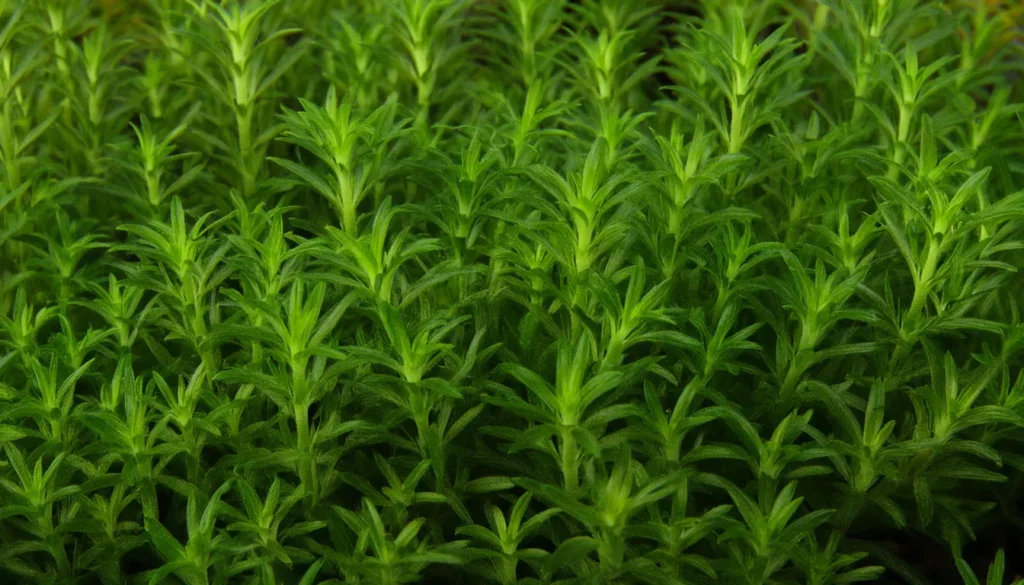
Key Takeaway
- Hemianthus Micranthemoides, or Pearl Weed, is a versatile carpet aquarium plant that can transform your freshwater tank into a lush and vibrant underwater oasis.
- Optimizing growth conditions, including lighting and substrate, is essential for successfully cultivating Pearl Weed.
- Techniques for achieving submerged growth and creative layout ideas can help you create stunning aquascaping designs with Pearl Weed.
- Regular maintenance, including pruning and monitoring water parameters, is crucial for the continued thriving of Pearl Weed in your aquarium.
- Following our planting tips and care guide, you can enjoy the beauty and tranquility of an aquatic oasis with Hemianthus Micranthemoides.
Quick Stats
| Attribute | Details |
| Family Name | Scrophulariaceae |
| Origin | North America |
| Height | 5-15 cm (2-6 inches), can grow taller with sufficient light |
| pH Range | 5.0 – 7.5 |
| CO2 Requirement | Low to Moderate |
| Growth Rate | Fast |
| Care Level | Moderate |
| Color Form | Bright Green |
| Water Conditions | 18-26°C (64-79°F), adaptable to a range of water hardness |
| Max Size | Can be trimmed to maintain desired height and density |
| Lighting | Moderate to High |
| Supplements | CO2 supplementation enhances growth; benefits from liquid fertilizers |
| Placement | Foreground to Midground |
| Propagation | Stem cuttings |
What Is Hemianthus Micranthemoides?
Hemianthus Micranthemoides, commonly known as Pearl Weed, is a versatile and beautiful aquatic plant that adds a vibrant touch to any aquarium.
This plant is highly sought after for its ability to form a dense carpet, making it a popular choice for aquascaping enthusiasts.
But before we dive into the planting tips and maintenance routines, let’s explore the historical background and species profile of Hemianthus Micranthemoides.
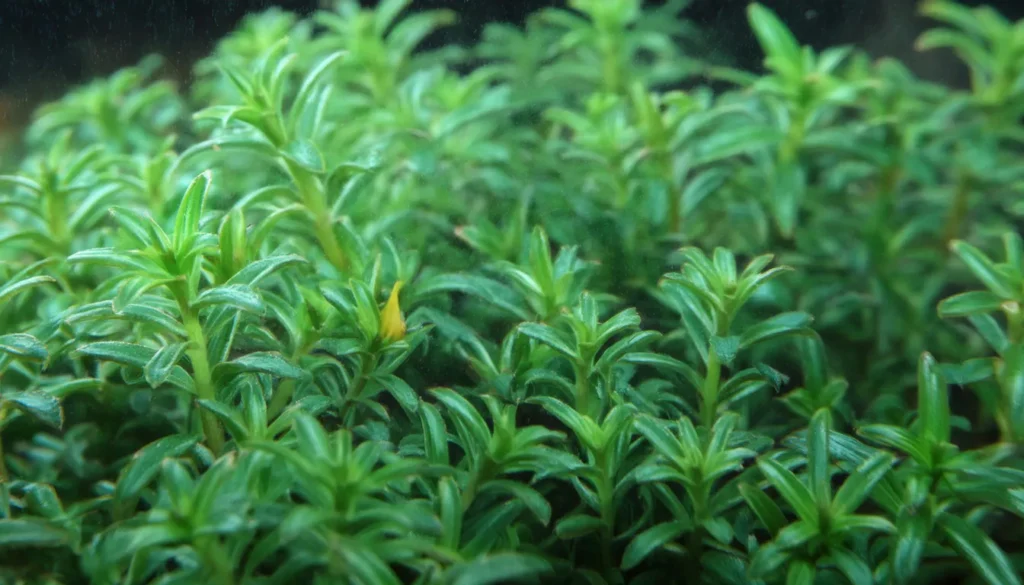
Historical Background And Species Profile
Hemianthus Micranthemoides, belonging to the family Scrophulariaceae, is native to North and Central America.
Over the years, this plant has been cultivated and cherished in the aquarium hobby for its fast growth rate and aesthetic appeal.
It is closely related to another popular aquatic plant, Hemianthus Callitrichoides (Dwarf Baby Tears).
Pearl Weed’s historical significance and widespread presence in the aquarium community make it an interesting and valuable addition to any aquatic landscape.
Physical Characteristics
- Leaf Shape and Size: The leaves of H. micranthemoides are small, round to oval-shaped, and relatively thin. They typically measure around 0.5 to 1 centimeter (0.2 to 0.4 inches) in length.
- Coloration: The leaves of H. micranthemoides can vary in color depending on growth conditions and lighting intensity. They often display shades of green, ranging from light green to darker shades.
- Growth Habit: H. micranthemoides has a creeping or trailing growth habit. It spreads horizontally along the substrate or can grow vertically when allowed to reach the water’s surface. In aquariums, it often forms dense mats or carpets under optimal conditions.
- Stem Structure: Like many stem plants, H. micranthemoides has a thin, flexible stem that bears leaves along its length. The stems can grow quite long, allowing the plant to spread and fill in available space in the aquarium.
- Root System: H. micranthemoides develops a fine and relatively shallow root system. While the roots anchor the plant to the substrate, they are not as robust as those of some other aquatic plants.

Lighting Needs Of The Plant
- Moderate to High Light: While not as demanding as some other aquatic plants, H. micranthemoides thrives best under moderate to high lighting conditions. Providing sufficient light intensity ensures robust growth and vibrant coloration.
- Full-Spectrum Lighting: Use full-spectrum aquarium lighting fixtures that provide a balanced spectrum of light, including both red and blue wavelengths. This helps promote photosynthesis and overall plant health.
- Duration: Provide a photoperiod of around 8 to 10 hours per day. This mimics natural daylight cycles and allows H. micranthemoides to undergo photosynthesis while still providing a period of rest.
- Avoid Excessive Lighting: While H. micranthemoides benefits from moderate to high light, excessive lighting can lead to algae overgrowth and stress the plant. Monitor the intensity and duration of lighting to prevent issues such as algae blooms.
- Adjustable Lighting: Consider using lighting fixtures with adjustable intensity or dimmer controls. This allows you to fine-tune the light levels to meet the specific needs of H. micranthemoides and other plants in your aquarium.
Optimal Water Condition
- Temperature: Keep the water temperature in the range of 20°C to 28°C (68°F to 82°F). Maintaining stable temperatures within this range promotes healthy growth and prevents stress on the plants.
- pH Level: Aim for a slightly acidic to neutral pH level between 6.0 and 7.5. Most aquarium plants, including H. micranthemoides, thrive within this pH range.
- Water Hardness: H. micranthemoides can adapt to a wide range of water hardness levels (measured in dGH). Ideally, keep the water hardness between 2 to 15 dGH (soft to moderately hard water).
- Ammonia, Nitrite, and Nitrate Levels: Keep ammonia and nitrite levels at zero, as they are toxic to aquarium plants and fish. Nitrate levels should be kept below 20 ppm (parts per million) to prevent algae overgrowth while still providing essential nutrients for plant growth.
- CO2 Levels: While not strictly a water parameter, maintaining adequate CO2 levels is crucial for the health and growth of H. micranthemoides. Aim for CO2 levels between 20 to 30 ppm (parts per million) to support optimal photosynthesis and growth.
Temperature Parameters
The optimal temperature parameters for Hemianthus micranthemoides (pearlweed) in an aquarium range from 20°C to 28°C (68°F to 82°F).
Maintaining water temperatures within this range promotes healthy growth and overall well-being for the plant.
It’s essential to monitor and regulate temperature fluctuations to prevent stress and ensure optimal conditions for growth.
Using a reliable aquarium thermometer and a heater (if necessary) can help maintain stable temperatures within the recommended range.
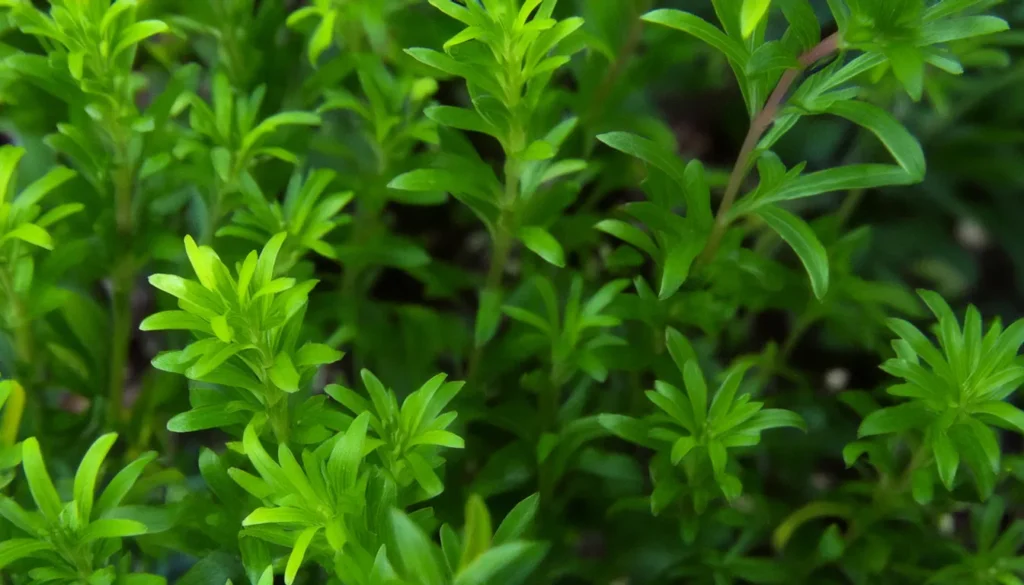
Substrate Requirement
- Nutrient-Rich Substrate: Choose a substrate specifically designed for planted aquariums, such as nutrient-rich aquasoil or nutrient-enriched gravel. These substrates contain essential nutrients like nitrogen, phosphorus, and potassium, which are vital for plant growth.
- Fine Texture: Opt for a substrate with a fine texture, such as sand or fine gravel. A fine substrate allows the plant’s delicate roots to anchor securely and spread easily, facilitating growth and nutrient uptake.
- Iron Content: Ensure that the substrate contains sufficient iron, as it is essential for healthy plant growth and vibrant coloration. Iron-rich substrates or substrate additives can help meet this requirement.
- Depth: Provide a substrate depth of at least 2 to 3 inches (5 to 7.5 cm) to allow ample room for root penetration and stability. A deeper substrate layer provides a reservoir for nutrients and promotes healthy root development.
- CO2 Diffusion: Consider using a substrate that facilitates CO2 diffusion, as CO2 supplementation enhances plant growth. Substrates with porous structures or mineral-rich components can aid in CO2 diffusion and uptake by plant roots.
RELATED: Echinodorus Red Flame To Aesthetically Design Your Aquarium
Placement Option In The Tank
- Foreground: Plant pearlweed in the foreground of the aquarium to create a lush carpeting effect. This placement adds visual depth and enhances the overall aesthetics of the aquascape. Arrange pearlweed in small clusters or rows along the front of the tank for a cohesive look.
- Midground: Pearlweed can also be placed in the midground of the aquarium, particularly in smaller tanks or aquascapes. Use it to fill in gaps between other foreground and background plants, adding texture and interest to the middle portion of the tank.
- Background: While less common, pearlweed can be used as a background plant in smaller tanks or aquascapes. Plant it in dense clusters along the back wall of the aquarium to create a vibrant green backdrop. Trim and shape pearlweed regularly to maintain a neat appearance.
- Around Hardscape: Plant pearlweed around hardscape elements such as rocks, driftwood, or aquarium decorations. This placement softens the edges of the hardscape and integrates the plants with the overall design. Arrange pearlweed in small groups or along the base of the hardscape for a natural look.
Recommended Tank Size
- Nano Tanks: Pearlweed is well-suited for nano tanks, typically ranging from 2.5 to 10 gallons. Its compact size and fast growth rate make it an excellent choice for smaller setups, where it can create lush carpeting effects or fill in gaps between hardscape elements.
- Small to Medium Tanks: Pearlweed can also thrive in small to medium-sized tanks, ranging from 10 to 50 gallons. In these setups, pearlweed can be used to create vibrant foreground carpets, midground clusters, or background accents, depending on your aquascape design.
- Large Tanks: While less common, pearlweed can be used in larger tanks exceeding 50 gallons. In these setups, pearlweed can be planted in multiple areas to create cohesive carpeting effects or to fill in empty spaces between larger plants and hardscape features.
- Aquascapes with High Light and CO2: If you plan to maintain high light levels and supplement CO2 in your aquarium, pearlweed can thrive in smaller tanks with these conditions. In such setups, pearlweed can grow densely and create lush, vibrant carpets that enhance the overall aesthetics of the tank.
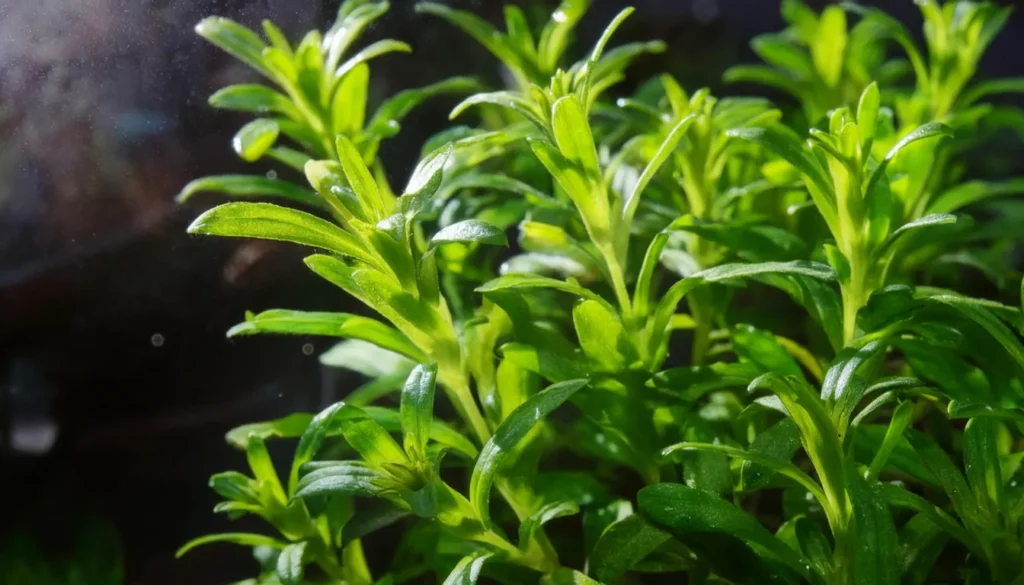
Suitable Tank Mates
- Small Fish Species: Pearlweed pairs well with small, peaceful fish species that won’t uproot or disturb the plants. Examples include neon tetras, celestial pearl danios, ember tetras, and dwarf rasboras.
- Shrimp: Many freshwater shrimp species, such as cherry shrimp, crystal red shrimp, and amano shrimp, make excellent tank mates for pearlweed. Shrimp help keep the aquarium clean by consuming algae and detritus, and they generally don’t bother the plants.
- Snails: Snails like nerite snails, Malaysian trumpet snails, and ramshorn snails can coexist with pearlweed without causing harm. They aid in algae control and substrate maintenance, contributing to the overall health of the aquarium.
- Bottom Dwellers: Peaceful bottom-dwelling species like otocinclus catfish, dwarf Corydoras catfish, and small loaches can complement pearlweed nicely. These fish species help clean the substrate and contribute to the overall balance of the aquarium.
- Non-Aggressive Invertebrates: In addition to shrimp, other non-aggressive invertebrates like small freshwater clams and dwarf crayfish can cohabit with pearlweed without causing issues. Ensure that any invertebrates you add are compatible with your chosen fish species and aquarium conditions.
Nutritional Needs Of The Plant
Hemianthus micranthemoides (pearlweed) requires several essential nutrients to support healthy growth and development. These include both macro and micronutrients:
Macro Nutrients
- Nitrogen (N): Necessary for protein synthesis and overall plant growth.
- Phosphorus (P): Essential for energy transfer and root development.
- Potassium (K): Important for osmoregulation, enzyme activation, and overall plant health.
Micro Nutrients
- Iron (Fe): Crucial for chlorophyll production and photosynthesis.
- Magnesium (Mg): Required for enzyme activation and photosynthesis.
- Calcium (Ca): Essential for cell wall structure and membrane integrity.
- Sulfur (S): Necessary for protein synthesis and enzyme function.
- Boron (B): Important for cell wall formation and carbohydrate metabolism.
- Copper (Cu): Required for enzyme activation and photosynthesis.
- Manganese (Mn): Essential for chlorophyll production and enzyme activation.
- Molybdenum (Mo): Important for nitrogen metabolism and enzyme function.
- Zinc (Zn): Necessary for enzyme activation and hormone regulation.
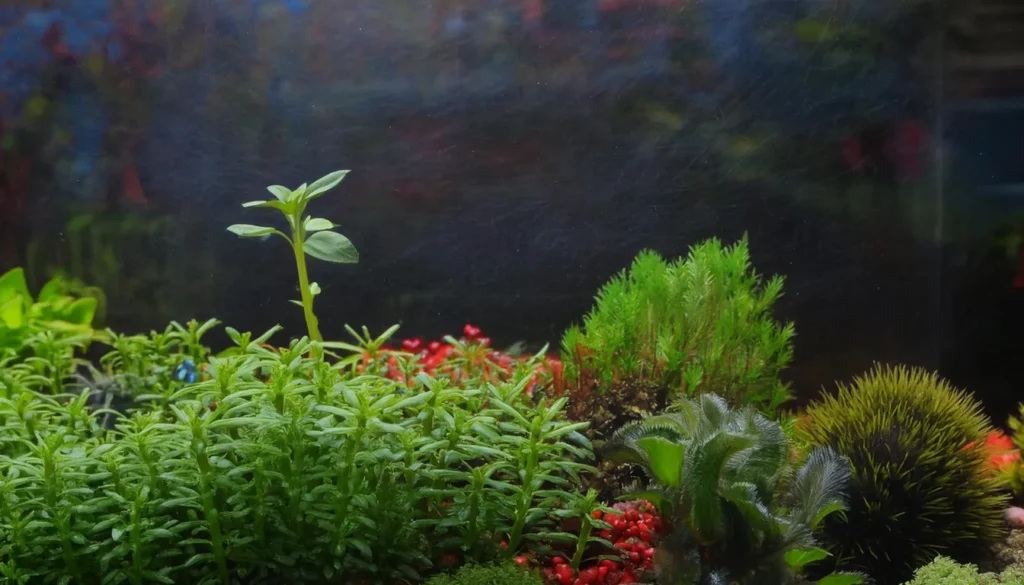
Hemianthus Micranthemoides Cultivation Tips
- Lighting: Provide moderate to high lighting levels for optimal growth. Pearlweed thrives under intense light, so use LED fixtures or fluorescent tubes to ensure sufficient illumination. Aim for a lighting duration of 8 to 10 hours per day to simulate natural daylight cycles.
- CO2 Supplementation: Consider supplementing carbon dioxide (CO2) to promote robust growth and vibrant coloration. CO2 injection systems or liquid carbon supplements can help maintain adequate CO2 levels in the water. Ensure that CO2 supplementation is balanced with lighting and nutrient levels to prevent algae overgrowth.
- Nutrient-Rich Substrate: Plant pearlweed in a nutrient-rich substrate to provide essential nutrients for healthy growth. Use aquarium soil, nutrient-enriched gravel, or substrate additives to ensure an adequate supply of nutrients, including nitrogen, phosphorus, potassium, and trace elements.
- Fertilization: Supplement with liquid fertilizers or root tabs to provide additional nutrients as needed. Regularly monitor nutrient levels and adjust fertilization accordingly to prevent deficiencies or excesses. Follow the recommended dosage instructions provided by the fertilizer manufacturer.
Plant Propagation Tips
- When selecting stems for propagation, choose healthy and robust stems from the parent plant. Avoid stems that show signs of damage, disease, or nutrient deficiencies.
- Use sharp and clean scissors or aquascaping tools to make clean cuts. This helps prevent damage to the stems and reduces the risk of introducing pathogens into the aquarium.
- Cut the stems into sections that are approximately 2 to 4 inches (5 to 10 cm) in length. Ensure that each cutting has at least two sets of leaves intact, as these are essential for photosynthesis and growth.
- Before planting, remove any lower leaves from the stem cuttings. This exposes a clean section of the stem, which promotes better root development when planted in the substrate.
- When planting the stem cuttings, bury at least one node (where the leaves were attached) into the substrate. This node is where new roots will emerge, anchoring the cutting into the substrate and providing it with access to nutrients.
RELATED: Echinodorus Helanthium Tenellus Care Guide For Beginners
Benefits Of Planting Hemianthus Micranthemoides
- Natural Aquascape Aesthetic: Hemianthus micranthemoides forms dense, carpet-like mats of vibrant green foliage, adding a lush and natural aesthetic to your aquascape. Its compact growth habit and fine-textured leaves create a visually appealing contrast with other plants and hardscape elements.
- Oxygenation: Like all aquatic plants, pearlweed contributes to oxygenation by absorbing carbon dioxide (CO2) and releasing oxygen through photosynthesis. This helps maintain a healthy and well-oxygenated environment for fish and other aquatic inhabitants.
- Water Filtration: Pearlweed helps to filter and purify the water by absorbing nutrients such as nitrates, ammonia, and phosphates, which are produced as waste products by fish and decaying organic matter. This natural filtration process helps to maintain water quality and reduce the risk of algae blooms.
- Algae Control: The dense growth of Hemianthus micranthemoides can outcompete algae for nutrients and light, helping to prevent the growth of undesirable algae species in the aquarium. By maintaining healthy and vigorous growth, pearlweed contributes to natural algae control.
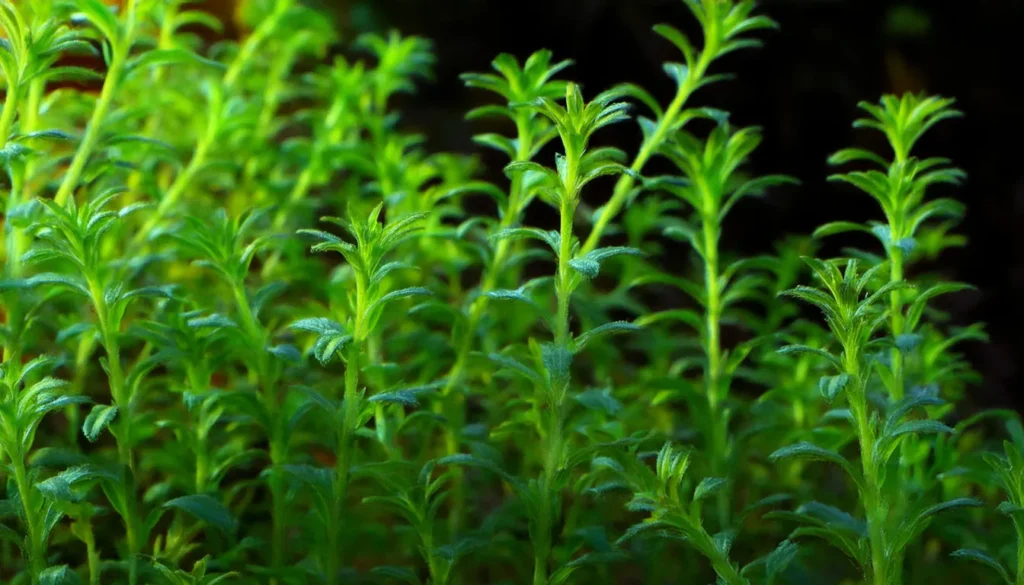
Addressing Common Challenges In Cultivating Hemianthus Micranthemoides
Cultivating Hemianthus Micranthemoides (Pearl Weed) may come with certain challenges that aquarists may face.
One common challenge is algae growth, which can be addressed by ensuring proper lighting, water circulation, and the introduction of algae-eating fish or invertebrates.
Slow growth or browning of the plant can be a sign of inadequate lighting or nutrient deficiencies, which can be solved by adjusting the lighting intensity and providing the necessary nutrients through fertilizers or substrate additives.
Regular maintenance and monitoring of water parameters will help prevent and address common challenges encountered when cultivating Pearl Weed.
| Challenge | Solution |
| Algae growth | Ensure proper lighting, water circulation, and introduce algae-eating fish or invertebrates. |
| Slow growth or browning | Adjust lighting intensity and provide necessary nutrients through fertilizers or substrate additives. |
| Inadequate lighting | Use appropriate lighting equipment and adjust light duration and intensity. |
| Nutrient deficiencies | Provide the necessary nutrients through fertilizers or substrate additives. |
| Water parameter fluctuations | Maintain consistent water parameters through regular monitoring and appropriate adjustments. |
Conclusion
Hemianthus Micranthemoides (Pearl Weed) is a versatile and beautiful aquatic plant that can transform your aquarium into a vibrant and lush underwater oasis.
By following our essential planting tips, optimizing the growth conditions, and implementing regular maintenance routines, you can ensure the continued success and health of your Pearl Weed carpet.
The careful integration of Pearl Weed into your aquascape designs and the pairing of other compatible aquatic plants can result in stunning and visually appealing layouts in your aquarium.
The possibilities are endless, from creating a lush carpet in the foreground to designing islands of Pearl Weed surrounded by other plants or hardscape elements in the mid-ground.
Let your creativity flow and experiment to find the perfect layout for your aquatic masterpiece.
While certain challenges may arise during the cultivation of Pearl Weed, fear not. With our troubleshooting techniques, you can confidently overcome any issues that may come your way.
We’ve got you covered, from addressing algae growth to promoting healthy growth through adequate lighting and nutrient supplementation.
Frequently Asked Question
What Are The Growth Conditions For Hemianthus Micranthemoides?
Hemianthus Micranthemoides (Pearl Weed) requires moderate to high light levels, a nutrient-rich planting substrate, and water parameters within the appropriate range.
For optimal growth, maintain a temperature of 72-82°F (22-28°C), pH level of 6.0-7.5, and water hardness of 2-10 dKH.
How Do I Maintain Hemianthus Micranthemoides?
Regular maintenance of Hemianthus Micranthemoides (Pearl Weed) includes pruning to maintain shape and prevent overcrowding, removing dead or decaying leaves, and performing regular water changes to maintain optimal water parameters.
Monitoring nutrient levels and addressing any issues promptly is also important.
What Techniques Can I Use To Encourage Submerged Growth In Hemianthus Micranthemoides?
To encourage submerged growth in Hemianthus Micranthemoides (Pearl Weed), ensure proper placement and spacing of individual plants or small clumps in the substrate.
Provide adequate lighting and, if necessary, CO2 supplementation, and maintain optimal water conditions through regular pruning and proper water maintenance.
How Can I Integrate Pearl Weed Into My Aquascaping Designs?
You can integrate Pearl Weed into your aquascape designs by creating a lush carpet in the foreground of the aquarium or by creating islands of Pearl Weed in the mid-ground surrounded by other plants or hardscape elements.
These layouts create visual interest and depth in the aquarium.
What Are Some Common Challenges In Cultivating Hemianthus Micranthemoides?
Common challenges in cultivating Hemianthus Micranthemoides (Pearl Weed) include algae growth, slow growth, and plant browning.
These challenges can be addressed by ensuring proper lighting, water circulation, nutrient supplementation, and regular maintenance.
- Unveiling The Wonders Of Riccia Fluitans In Aquascapes - August 7, 2024
- Vallisneria Gigantea Var. Guide To Care And Cultivation At Home - July 31, 2024
- Vesicularia Dubyana Care & Growth Guide Tips For Beginner Gardeners - July 30, 2024
